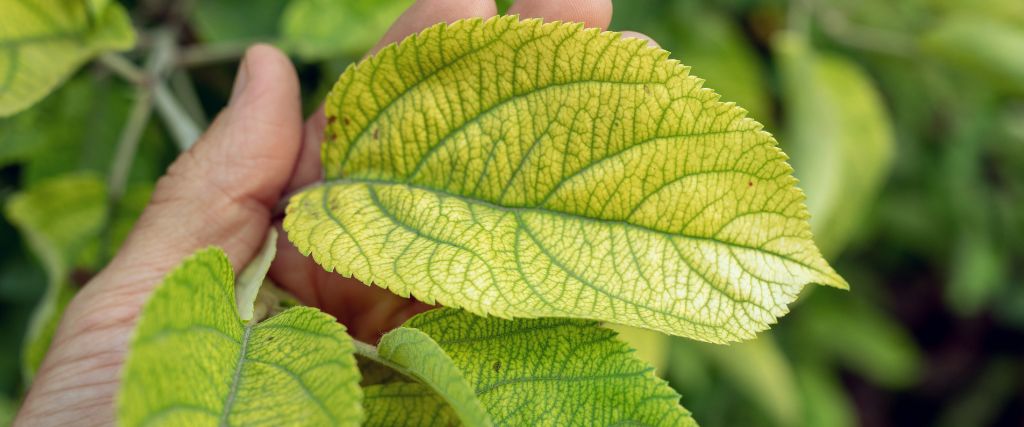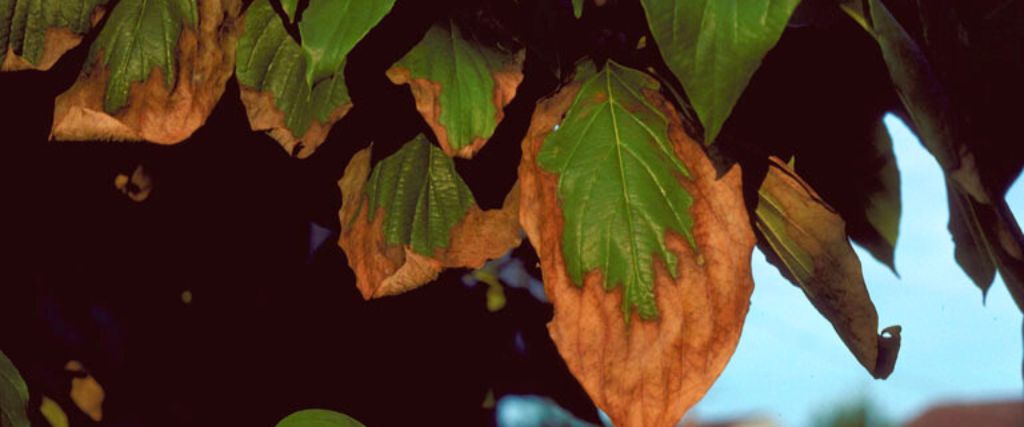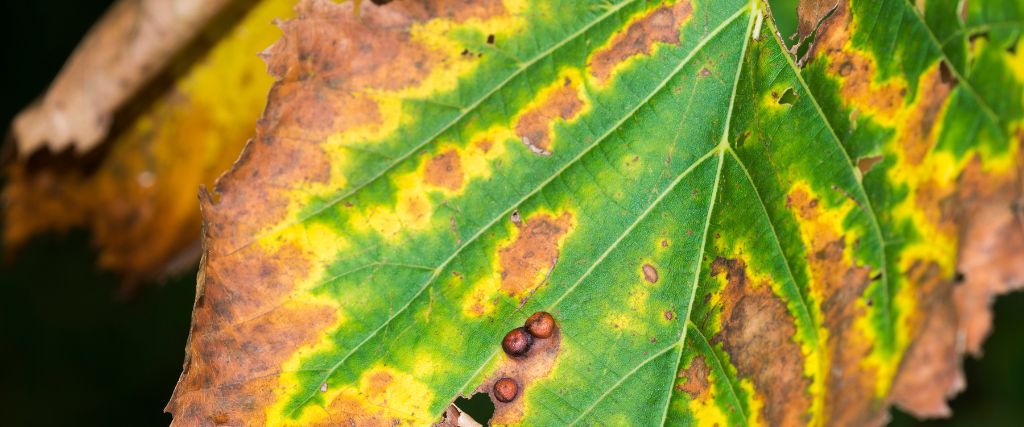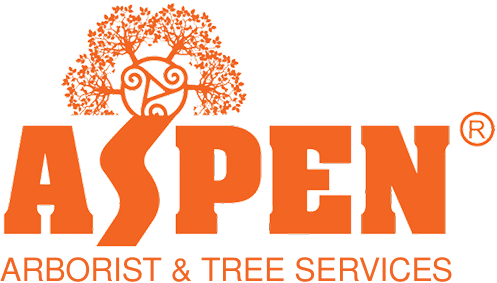Leaf scorch refers to the browning and drying up of leaf edges, giving them a scorched or burnt appearance. It’s a common condition that affects many trees in New Jersey, although the outcome for scorched trees varies greatly depending on the cause; some trees recover quickly while others decline and die. Tree death from leaf scorch is usually caused by Bacterial Leaf Scorch, a lethal disease that’s putting more than 60% of New Jersey’s oak trees at risk.
In this article, you’ll learn the different factors that contribute to leaf scorch in New Jersey trees, how to differentiate between the various types of scorch, and the best prevention and treatment methods for each. So, let’s dive in and uncover the root causes of leaf scorch in trees!
Key Takeaways
- Leaf scorch is a common condition that affects trees in New Jersey, leading to browning and drying up of leaf edges and giving them a burnt appearance.
- In New Jersey, three primary factors, environmental stressors, nutrient deficiencies, and bacterial leaf scorch infections, can contribute to leaf scorch.
- Each cause results in different outcomes for your trees, from temporary effects on appearance to tree decline and death.
- Recognizing which type of leaf scorch is affecting your trees can help and treatment and prevention.
- Proper tree care, including watering, mulching, and fertilizing, is essential in minimizing the occurrence of all three kinds of leaf scorch.
- If you notice severe leaf scorch or need professional assistance, tree care specialists like Aspen Tree Care can provide expert advice and services.
Understanding Leaf Scorch in Trees
Leaf scorch is a condition that affects trees when they are unable to meet their water requirements. This results in the drying out and browning of leaf edges, giving them a scorched appearance.
Common symptoms of leaf scorch include:
- Browning and wilting of leaf edges
- Yellowing of leaves
- Premature leaf drop
PRO TIP: Leaf scorch can sometimes be mistaken for other conditions such as oak wilt or Dutch elm disease. By understanding the common symptoms of leaf scorch, you’ll be better able identify the issue and take the necessary steps to prevent further damage.

Nutrient deficiencies, such as a lack of iron, nitrogen, and potassium, can contribute to tree leaves’ yellow and sometimes burnt appearance.
3 Causes of Scorched Tree Leaves in New Jersey
Leaf scorch in trees in New Jersey can be caused by various factors, including environmental stressors, nutrient deficiencies, and bacterial leaf scorch, each of which can cause significant problems for trees, impacting their overall health and aesthetic appeal. The key is to understand and be able to identify the various causes of burnt-looking tree leaves so you’ll know whether the issue can be effectively resolved and/or prevented, or whether you may need to remove your tree.
#1 – Environmental Stressors That Lead to Leaf Scorch
Burnt-looking leaves in Northern New Jersey can be caused by environmental stress factors like high temperatures, intense sun exposure, and drought, all of which lead to insufficient water uptake by trees and shrubs. During periods of extreme heat or limited water availability, trees may experience water loss and dehydration, leading to the browning and drying up of leaf edges. These stressors can particularly affect trees with shallow roots and those growing in urban areas.
Leaf scorch typically manifests as dry, brown leaf margins due to the plant’s inability to absorb enough water to meet its needs. This leads to dehydrated leaves with brown, shriveled tips that appear burned.
#2 – Nutrient Deficiencies Can Cause Burnt-Looking Leaves
Nutrient deficiencies, especially in essential elements like nitrogen, can result in leaves with a burnt appearance. When trees lack necessary nutrients, their ability to perform essential functions, such as photosynthesis, is impaired. This can lead to leaf discoloration, wilting, and scorching.
#3 – Bacterial Leaf Scorch (BLS)
Bacterial leaf scorch (BLS) is a fatal disease caused by the bacterium Xylella fastidiosa. This disease is transmitted by insects, including leafhoppers and spittlebugs, to susceptible tree species. BLS affects the xylem, the water transport system of the tree, leading to symptoms such as leaf scorch, dieback, and stunted growth. Identifying the signs of BLS, such as browning and drying leaf margins, can help you initiate timely management strategies.
Bacterial leaf scorch affects a wide range of tree species in the Garden State, including:
- Oaks – Many varieties of oak are susceptible, including red, pin, and black oaks. The disease can lead to a slow but steady decline in these majestic trees.
- Elms – While elms are generally resilient, they’re not immune to bacterial leaf scorch. This disease can cause yellowing and scorching of leaves, leading to premature leaf drop.
- Sycamores – Sycamores are also victims of this disease. Infected trees may display browning of the leaf margins and an overall decline in health and vigor.
However, don’t think these are the only species at risk – bacterial leaf scorch can target many other species as well. You may have seen the signs in your own backyard without realizing what you were looking at.
Distinguishing Bacterial Leaf Scorch from Other Conditions
Differentiating between bacterial leaf scorch, scorch caused by nutrient deficiencies, and environmental leaf scorch is critical for implementing appropriate control measures.
While all three conditions may result in scorched-looking leaves, bacterial leaf scorch is caused by a specific pathogen and requires targeted treatments, such as antibiotic injections. Environmental leaf scorch and leaf browning caused by nutrient deficiencies, on the other hand, are primarily a result of environmental stressors and can be managed through proper tree care and mitigation of stress factors.
To differentiate between leaf scorch caused by environmental factors and bacterial leaf scorch, ask yourself these questions:
1. Where do you see the symptoms?
- Environmental Factors – Leaf scorch due to environmental factors like drought typically affects upper branches and younger leaves near the tips of branches first.
- Nutrient Deficiencies – The location of nutrient deficiency symptoms will vary depending on the particular elements lacking. For example, manganese deficiencies may first appear on older leaves, while boron deficiencies often affect the youngest leaves.
- Bacterial Leaf Scorch – Symptoms of bacterial leaf scorch often appear on lower branches and old interior leaves initially before spreading to other parts of the tree.
2. Is there a noticeable pattern to the observed leaf browning?
- Environmental Factors – Browning due to environmental stressors is usually uniform and may affect entire leaves or sections of leaves consistently.
- Nutrient Deficiencies – Nutrient deficiencies typically result in specific patterns of discoloration or yellowing on leaves depending on the lacking nutrient. For example, nitrogen deficiency leads to overall yellowing of leaves.
- Bacterial Leaf Scorch – In bacterial leaf scorch, necrosis begins along the leaf margin and spreads irregularly toward the veins, with a yellow or reddish-brown band separating dead tissue from healthy tissue.
3. When do symptoms appear?
- Environmental Factors – Symptoms occur during periods of drought or high heat and can be prevented with deep and regular irrigation.
- Nutrient Deficiencies – Signs of nutrient deficiency, including browning, drying, and curling of leaf edges, can occur any time during the growing season.
- Bacterial Leaf Scorch – In New Jersey, you’re most likely to see leaf browning from BLS starting in late summer to early fall, making it easy to confuse the scorched leaves with early fall color.
4. Do the symptoms recur and progress from year to year?
- Environmental Factors – Symptoms caused by environmental stress may vary in severity depending on weather conditions but are not consistent year after year.
- Nutrient Deficiencies – If the tree is treated by fertilizing it with the appropriate macro- and micronutrients, you shouldn’t see a recurrence of the symptoms the next year (assuming you’re also following proper tree maintenance practices).
- Bacterial Leaf Scorch – Bacterial leaf scorch symptoms reappear in the same limbs year after year, progressively worsening and eventually spreading to other limbs, leading to premature tree death.
By observing the location of symptoms, the pattern of browning, timing, and the consistency of symptoms over time, you can differentiate between leaf scorch caused by environmental and soil fertility factors versus bacterial leaf scorch. If in doubt, consult with a NJ Licensed Tree Expert for a thorough tree assessment and diagnosis.
BLS Diagnosis Tip – Bacterial leaf scorch is properly diagnosed through visual inspection of the tree’s symptoms and then confirmed through laboratory testing. While visual inspection can provide initial indications, a laboratory test is necessary to definitively diagnose bacterial leaf scorch and rule out other potential causes for the scorched-like appearance of leaves.

Preventing and Treating 3 Types of Leaf Scorch in New Jersey Trees
While leaf scorch can be challenging to prevent entirely, there are steps you can take to minimize its occurrence. The key is understanding what’s causing the burnt and shriveled leaves on your tree so you can effectively manage the cause of the problem.
Proper and ongoing tree maintenance, including regular watering, mulching, and fertilizing, can help keep trees healthy and reduce the risk of leaf scorch. It’s also important to monitor and address any nutrient deficiencies promptly and provide adequate irrigation during dry periods.
If leaf scorch is already present, there are treatment options available to manage the symptoms and slow the decline of affected trees. Consulting with a professional tree care specialist like the experts at Aspen Tree Service will help you determine the most effective course of action for your scorched trees.
How to Treat Environmental Leaf Scorch
Drought and extreme heat do sometimes affect the Garden State. Follow the tips below to treat leaf scorch caused by these environmental factors.
- Water deeply & water more often during dry or hot weather – Ensure that trees receive adequate water during dry spells or periods of extreme heat to help alleviate water stress and prevent leaf scorch. Deep watering is essential to ensure moisture reaches the roots effectively.
- Keep soil cool and moist with organic mulch – Apply mulch around the base of trees to help retain soil moisture, regulate soil temperature, and reduce water evaporation. Mulching can aid in minimizing water stress and maintaining tree health during challenging environmental conditions.
- Alleviate environmental stressors – While you can’t control the weather, there are things you can do to mitigate environmental stress factors like extreme temperatures or prolonged dry spells. Providing shade, using protective covers, or adjusting watering schedules can help trees better cope with adverse environmental conditions.
- Get an arborist assessment – If leaf scorch persists despite these interventions, consider seeking advice from a tree care professional or arborist to assess the extent of damage and determine additional treatment options specific to the environmental factors affecting the trees.
How to Treat Leaf Scorching Caused by Nutrient Deficiencies
To treat leaf scorch caused by nutrient deficiencies in New Jersey, you’ll need to address the underlying lack of essential nutrients that the tree requires for healthy growth. Here are steps to treat leaf scorch caused by nutrient deficiencies:
- Perform a soil test – Conduct a soil test to identify the specific nutrient deficiencies affecting the tree. This will help determine which nutrients are lacking and guide the appropriate treatment plan.
- Apply fertilizer as necessary – Based on the results of the soil test, fertilize the tree roots accordingly to provide the necessary nutrients. Choose a fertilizer that addresses the specific deficiencies identified in the soil test.
- Water deeply – Ensure that the tree receives sufficient water, especially during dry spells, to help with nutrient uptake and overall tree health.
- Consult with an arborist – If the nutrient deficiency is severe or if you are unsure about the appropriate treatment, consider consulting with an arborist or tree care professional for expert advice and guidance on addressing nutrient deficiencies effectively.
Treating Bacterial Leaf Scorch in New Jersey
Bacterial leaf scorch is a challenging disease to treat as there is currently no known cure for it. However, various management practices can be implemented to help prolong the life of infected trees and suppress symptoms. These practices include:
- Inject the tree with antibiotics – Trunk injections of antibiotics may help suppress symptoms and prolong the life of the tree. This treatment is not a cure and must be re-administered annually to maintain its effectiveness.
- Reduce water stress – Implementing measures to reduce water stress through mulching, proper irrigation, and using tree growth regulators to provide a long-lasting reduction in tree growth (this lowers the tree’s water needs) can aid in managing the impact of bacterial leaf scorch on trees.
- Control the pests that spread the disease – Controlling leafhoppers and other insects that spread the bacterium can help reduce the spread of the disease within tree populations.
- Prune out infected branches – Newly infected trees can be made to look somewhat presentable for a few more years if the dead wood is pruned out.
- Seek professional help – A qualified arborist will be able to accurately diagnose BLS, plan appropriate treatment, and properly administer treatments like trunk injections.
- Remove the tree – When the health of a diseased tree has declined to the point that it looks unsightly or becomes a hazard, the only option is to cut it down and have it removed.
While treatments for bacterial leaf scorch do not provide a cure, they can help manage symptoms, prolong the life of infected trees, and reduce the impact of the disease on tree health. Trees may live for 5 to 10 years with consistent treatment but most will eventually succumb to the disease.

Symptoms of bacterial leaf scorch may appear similar to scorch caused by other conditions, but the outcomes are very different. BLS-infected trees will eventually succumb to the disease.
When to Call a Tree Care Specialist
When dealing with tree health issues like leaf scorch, it’s important to know when to call a specialist. If you notice severe or widespread leaf scorch on your trees, it’s always best to seek professional help.
If you are unsure about the severity of leaf scorch on your trees, it is recommended to consult with tree care specialists in New Jersey. These professionals have the knowledge and expertise to accurately diagnose tree health issues and provide the appropriate treatments or solutions.
Tree health specialists, like the arborists at Aspen Tree Service, can assess the condition of your trees, identify the underlying causes of leaf scorch, and recommend the most effective course of action. They have specialized tools, techniques, and experience in handling various tree diseases and disorders, ensuring the health and longevity of your trees.
Concerned About Leaf Scorch? Call Aspen Tree!
If you’ve noticed leaf scorch on your trees or require professional tree care services in northern New Jersey, Aspen Tree Service is here to provide expert assistance. With our extensive knowledge and experience, our team of Licensed Tree Experts and Certified Arborists understand the complexities of leaf scorch and can provide tailored solutions to ensure the health and longevity of your trees.
Call Aspen Tree Service at 201-939-8733 for top-quality tree health services in New Jersey. We’re committed to maintaining the well-being of your trees and offer a range of expert solutions. Whether you need preventive measures or treatment for existing leaf scorch, Aspen Tree has you covered.





